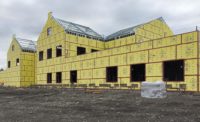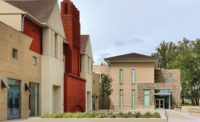A System That Works
A wall system helps achieve LEED-Gold Status for non-profit agency's new building in Maryland.

An innovative, highly energy-efficient wall system that reduces construction time and installation cost helped the recently completed headquarters of a government agency in Cumberland, Md., achieve LEED Gold certification.
The 20,594-square-foot building is the new home facility for the Human Resources Development Commission of Allegany County, Md. The project included the installation of the Syntheon accel-E Steel Thermal Efficient Panel wall system.
“When we began designing our building we decided we would attempt to build a building that had at least a LEED Gold certification,” says Dan Lewellen, deputy director of the HRDC. “The accel-E wall panel system was one of the factors that helped us garner LEED points and achieve that goal.”
The new wall system achieves its excellent energy efficiency by fusing cold-formed steel framing components and expandable polystyrene insulating panels together into a single continuous system. This eliminates air gaps, reduces thermal bridging and heat transference, blocks air intrusion, and adds thermal resistance. As a result, the panels offer tested insulating values that surpasses other panel systems and traditional framing techniques.
 “I have always liked products that give you a
better quality building envelope, and this seemed like a good way to go,” says
architect Gary Moshier, a partner of Moshier Studio, which designed the
facility.
“I have always liked products that give you a
better quality building envelope, and this seemed like a good way to go,” says
architect Gary Moshier, a partner of Moshier Studio, which designed the
facility.
In addition to improving long-term sustainability, the use of energy-saving technology such as the wall system has also produced more immediate and tangible benefits, HRDC’s Llewelen says. Those benefits became apparent when a review of the building’s performance as part of the LEED commissioning project revealed significant savings in energy and other utility costs.
“In a conventionally built building, the mixed-use utility costs for gas, water and electric in a building such as ours typically run about $3.15 or $3.16 per square foot, on an annualized basis,” Lewellen explains. “But after a year of occupancy we found our costs were running at about $2.15 or $2.16.”
“We engineer common sense sustainability for our customers,” said Jeff Peskowitz, Syntheon’s director of marketing. “Therefore, the system is very easy to install and, in addition to helping reduce energy costs, the accel-E wall system is also very ‘green’ in terms of it long-term environmental impact.”
LEED POINTS
Peskowitz noted that the wall system contributes points to as many as four LEED categories. The steel framing members are made of recycled steel and are themselves recyclable. In addition, the EPS foam insulation does not shrink, settle, emit harmful VOC gases, or contribute to diminished air quality. In fact the wall system has GreenGuard certification for indoor air quality. Moreover, replacing conventional framing and insulation with pre-engineered panels virtually eliminates job site waste and disposal issues-all of which further contribute to the system’s LEED points.
 Energy efficiency was a major factor in
specifying this type of wall system. “I think it was a combination of the
energy performance, plus fewer joints for a more controlled joining system than
other alternatives,” Moshier says. “Plus the fact that these panels contributed
to LEED points in the Energy Efficiency category was a
positive.”
Energy efficiency was a major factor in
specifying this type of wall system. “I think it was a combination of the
energy performance, plus fewer joints for a more controlled joining system than
other alternatives,” Moshier says. “Plus the fact that these panels contributed
to LEED points in the Energy Efficiency category was a
positive.”
Bud Curry, superintendent of Rycon Construction, the contractor for the project, says there were immediate benefits during the installation process: “I feel that the installation time was quick and that means you have only one setup and you’re done with the wall system. The accel-E wall system was definitely ahead of the game for us.”
The system streamlines the construction process and can reduce labor and onsite disposal costs. Window and door openings are pre-cut, and the open cavity simplifies the installation of electrical, plumbing and mechanical systems.
“A competing system offered a solid foam design, but we would have had to cut channels for the electrical and plumbing subcontractors later in the process,” explains Curry. “The system allows us to do all the conduits for plumbing and electrical without cutting foam. That was a great help to us.”
Curry adds he expects to be using the system again. “I think it’s got a great future, and I’m sure we’re going to see more of it,”
The panels are available in six and eight inches and can be produced in virtually any height, limited only by the mode of transportation.
”This building allowed us to consolidate four other separate sites under one roof, so we could create more of a one-stop shop for the people we serve,” Lellewen says.
The system fully complies with both the 2006 International Building Code and the 2006 International Residential Code. The panels’ R value and U factor exceed ASHRAE 90.1 2007 and IECC 2009 Energy Code requirements for cavity plus continuous insulation in steel stud wall assemblies for all climate zones
Lewellen says quality of life considerations mean a lot: “LEED Gold means the occupants’ satisfaction with their surroundings is higher, and you just have a cleaner environment for people to work in.”
The 160-employee nonprofit community action agency administers 19 separate programs aimed at improving the lives of the young, poor, elderly and disabled throughout Allegany County.

An innovative, highly energy-efficient wall system that reduces construction time and installation cost helped the recently completed headquarters of a government agency in Cumberland, Md., achieve LEED Gold certification.
The 20,594-square-foot building is the new home facility for the Human Resources Development Commission of Allegany County, Md. The project included the installation of the Syntheon accel-E Steel Thermal Efficient Panel wall system.
“When we began designing our building we decided we would attempt to build a building that had at least a LEED Gold certification,” says Dan Lewellen, deputy director of the HRDC. “The accel-E wall panel system was one of the factors that helped us garner LEED points and achieve that goal.”
The new wall system achieves its excellent energy efficiency by fusing cold-formed steel framing components and expandable polystyrene insulating panels together into a single continuous system. This eliminates air gaps, reduces thermal bridging and heat transference, blocks air intrusion, and adds thermal resistance. As a result, the panels offer tested insulating values that surpasses other panel systems and traditional framing techniques.

In addition to improving long-term sustainability, the use of energy-saving technology such as the wall system has also produced more immediate and tangible benefits, HRDC’s Llewelen says. Those benefits became apparent when a review of the building’s performance as part of the LEED commissioning project revealed significant savings in energy and other utility costs.
“In a conventionally built building, the mixed-use utility costs for gas, water and electric in a building such as ours typically run about $3.15 or $3.16 per square foot, on an annualized basis,” Lewellen explains. “But after a year of occupancy we found our costs were running at about $2.15 or $2.16.”
“We engineer common sense sustainability for our customers,” said Jeff Peskowitz, Syntheon’s director of marketing. “Therefore, the system is very easy to install and, in addition to helping reduce energy costs, the accel-E wall system is also very ‘green’ in terms of it long-term environmental impact.”
LEED POINTS
Peskowitz noted that the wall system contributes points to as many as four LEED categories. The steel framing members are made of recycled steel and are themselves recyclable. In addition, the EPS foam insulation does not shrink, settle, emit harmful VOC gases, or contribute to diminished air quality. In fact the wall system has GreenGuard certification for indoor air quality. Moreover, replacing conventional framing and insulation with pre-engineered panels virtually eliminates job site waste and disposal issues-all of which further contribute to the system’s LEED points.

Bud Curry, superintendent of Rycon Construction, the contractor for the project, says there were immediate benefits during the installation process: “I feel that the installation time was quick and that means you have only one setup and you’re done with the wall system. The accel-E wall system was definitely ahead of the game for us.”
The system streamlines the construction process and can reduce labor and onsite disposal costs. Window and door openings are pre-cut, and the open cavity simplifies the installation of electrical, plumbing and mechanical systems.
“A competing system offered a solid foam design, but we would have had to cut channels for the electrical and plumbing subcontractors later in the process,” explains Curry. “The system allows us to do all the conduits for plumbing and electrical without cutting foam. That was a great help to us.”
Curry adds he expects to be using the system again. “I think it’s got a great future, and I’m sure we’re going to see more of it,”
The panels are available in six and eight inches and can be produced in virtually any height, limited only by the mode of transportation.
”This building allowed us to consolidate four other separate sites under one roof, so we could create more of a one-stop shop for the people we serve,” Lellewen says.
The system fully complies with both the 2006 International Building Code and the 2006 International Residential Code. The panels’ R value and U factor exceed ASHRAE 90.1 2007 and IECC 2009 Energy Code requirements for cavity plus continuous insulation in steel stud wall assemblies for all climate zones
Lewellen says quality of life considerations mean a lot: “LEED Gold means the occupants’ satisfaction with their surroundings is higher, and you just have a cleaner environment for people to work in.”
The 160-employee nonprofit community action agency administers 19 separate programs aimed at improving the lives of the young, poor, elderly and disabled throughout Allegany County.
Looking for a reprint of this article?
From high-res PDFs to custom plaques, order your copy today!





